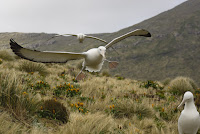The Gray Wolf
 Gray wolves (scientific name: Canis lupus) are gray as the name implies. But, they can also be black, white or red. They live in packs in the US, Canada, Europe, the Middle East and Asia. In Africa, they once lived in Egypt. There are five subspecies of gray wolves in North America; whose coat
colors can range from pure white to brown, gray, cinnamon or black. Today, worldwide, gray wolves are an endangered species.
Gray wolves (scientific name: Canis lupus) are gray as the name implies. But, they can also be black, white or red. They live in packs in the US, Canada, Europe, the Middle East and Asia. In Africa, they once lived in Egypt. There are five subspecies of gray wolves in North America; whose coat
colors can range from pure white to brown, gray, cinnamon or black. Today, worldwide, gray wolves are an endangered species.Summary: Wolves are - mammals, carnivorous and are the largest members of the dog family and are the largest wild canid. Their average life span is 6 to 8 years (14 to 15 years in captivity). And they can weigh any thing from 40lbs. to 177lbs. (18kg. to 80kg.). Their heights can be between 26 to 32 inches (660cm. to 813cm) and their lengths can be - that of males from nose to tip of tail, 5ft. to 6.5ft. (152cm. to 198cm.) and females from nose to tip of tail, from 4.5ft. to 6ft. (137cm. to 183cm.. Males are usually larger than females. Gray wolves travel in packs and are an endangered species.
Habitat: They are highly adaptable to most habitat, except tropical rainforests and arid deserts. They can be found in: savannas, taiga, tundra, plains, steppes, alpine and sub-alpine habitats, forests and woodlands. In the past, they have could be found in the dry deserts of Egypt and the bone chilling, icy tundras of the Arctic.
Wolf-packs: usually consist of 5-10 or 6-8 family members and are established according to a strict hierarchy, with a dominant male at the top and his mate not far behind. This dominant male and female - alphas or the mother and father - lead their packs while tracking and hunting; and they are the ones that choose dens for the pups or younger subordinate wolves. Usually this male and female are the only animals of the pack to breed. This pair, mates for life. All of a pack's adults help to care for young pups by bringing them food and watching them while others hunt. They typically hunt within territories, ranging from 50 to 1,000 square miles (80 to 1610 square kilometers).
Diet: Wolves prefer to eat large hoofed mammals, like elk, deer, moose and caribou; and are also known to eat beaver, rabbits and other small prey. Wolves are also scavengers and often eat animals that have died due to other causes like starvation and disease. On average, gray wolves will eat 20 to 30 pounds (9 to 14 kilograms) of meat in one meal, but have also been known stay up to 14 days without meals.
Population: There are an estimated 7,000 to 11,200 wolves in Alaska and more than 5,000 in the lower 48 states. Around the world there are an estimated 200,000 in 57 countries, compared to up to 2 million in earlier times.
Range: Wolves were once common throughout all of North America but were killed in most areas of the United States by the mid 1930s. Today their range has been reduced to Canada and the following portions of the United States: Alaska, Idaho, Michigan, Minnesota, Montana, Wisconsin and Wyoming. Mexican wolves are found in New Mexico and Arizona. Yellowstone National Park, where wolves were introduced in 1995, is one of the best places to see and hear wolves in the native habitat.
Behavior: Wolves live, travel and hunt in packs of 4-7 animals on average. Packs include the mother and father wolves, called the alphas, their pups and several other subordinate or young animals. The alpha female and male are the pack leaders that track and hunt prey, choose den sites and establish the pack's territory. Wolves develop close relationships and strong social bonds. They often demonstrate deep affection for their family and may even sacrifice themselves to protect the family unit.
Communication system: Wolves have a complex communication system that involves body language, barking, “dancing,” whining, growling, howling and scent making. While they don't howl at the moon, they do howl more when it's lighter at night, which occurs more often when the moon is full.
Mating Season: January or February.
Gestation: 60 to 63 days.
Litter size: 4-7 pups. Pups are born blind and defenseless. The pack cares for the pups until they mature at about 10 months of age.
Other interesting facts:
The Latin name for Gray Wolf, Canis lupus, is derived from the Latin Canis, meaning "dog", and lupus, "wolf". Wolf tracks can be difficult to distinguish from those of large dogs. Wolf and dog DNA differs by only two-tenths of one percent (0.2%). The Gray Wolf has been exterminated in many parts of North America. Howling is used as a form of communication among wolf packs. Wolves can reach speeds of 40 mph (65 kph) during a chase.
+ More reading: IUCN Red List, NWF, The Wild Ones, Defenders, International Wolf Center, Bear-Tracker, NPCA, National Geographic, Facts About Wolves, Wikipedia, Enchanted Learning
Image from: Google


